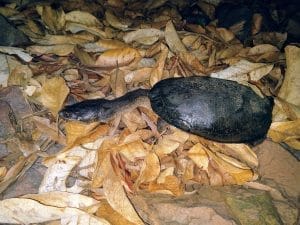Chelodina longicollis (Eastern Long-necked Turtle)
Home > Turtle Database > Chelodina longicollis (Eastern Long-necked Turtle)

Chelodina longicollis, also known as the Eastern Long-necked Turtle, is a unique species native to Australia. This turtle is easily recognized by its exceptionally long neck and distinctive shell shape.
Native Turtle Species Map – Find Turtles by Region
Scientific Classification
- Kingdom: Animalia
- Phylum: Chordata
- Class: Reptilia
- Order: Testudines
- Family: Chelidae
- Genus: Chelodina
- Species: C. longicollis
Common Names
- Eastern Long-necked Turtle
This Hilarious Turtle Book Might Know Your Pet Better Than You Do
Let’s be real—most turtle care guides feel like reading a textbook written by a sleep-deprived zookeeper.
This one’s not that.
Told from the snarky point of view of a grumpy, judgmental turtle, 21 Turtle Truths You’ll Never Read in a Care Guide is packed with sarcasm, sass, and surprisingly useful insights.
And hey—you don’t have to commit to the whole thing just yet.
Grab 2 free truths from the ebook and get a taste of what your turtle really thinks about your setup, your food choices, and that weird plastic palm tree.
It’s funny, it’s honest, and if you’ve ever owned a turtle who glares at you like you’re the problem—you’ll feel seen.
Identification
Description:
The Eastern Long-necked Turtle has an elongated neck that can extend as long as its carapace. Its shell is typically dark brown to black, while the plastron is lighter, often yellowish. The skin is greyish-brown, and the neck is marked with pale stripes.
Sexual Dimorphism:
Males tend to have a longer, thicker tail compared to females, which helps in distinguishing between the sexes.
Check more turtles from the Chelodina genus
Native Origin and Distribution
Geographical Range:
This species is found throughout eastern Australia, from Queensland to South Australia and inland to the Murray-Darling Basin.
Preferred Habitat
Chelodina longicollis prefers slow-moving freshwater habitats such as swamps, wetlands, and rivers. They can also be found in temporary water bodies and are known to travel considerable distances overland during droughts.
Behavior
Feeding Habits:
These turtles are carnivorous, feeding on a variety of aquatic invertebrates, small fish, and carrion. They use their long neck to strike quickly at prey.
Predators:
Natural predators include birds of prey, large fish, and introduced species like foxes and cats.
Reproduction
Breeding Season:
Breeding typically occurs in the spring and summer months, from September to January.
Reproductive Method:
Females lay clutches of 8-24 eggs in sandy or soft soil, which hatch after an incubation period of about 4-5 months.
Conservation
Extinction Status:
Chelodina longicollis is currently listed as Least Concern by the IUCN Red List.
Threats:
The main threats to this species include habitat destruction, pollution, and predation by introduced species.
Conservation Measures:
Conservation efforts include habitat protection, pollution control, and management of invasive species.
Economic Importance
The Eastern Long-necked Turtle is sometimes kept as a pet, contributing to the pet trade industry. It also plays a role in the ecosystem by controlling insect and fish populations.
Interesting Facts
- Chelodina longicollis can emit a foul-smelling liquid from glands in their armpits as a defense mechanism.
- They can travel overland for several kilometers to find new water sources during dry periods.
Research Studies
For an in-depth study, you can refer to the research paper titled: Habitat Utilization and Its Relationship to Growth and Reproduction of the Eastern Long-Necked Turtle, Chelodina longicollis

About Author
Muntaseer Rahman started keeping pet turtles back in 2013. He also owns the largest Turtle & Tortoise Facebook community in Bangladesh. These days he is mostly active on Facebook.














